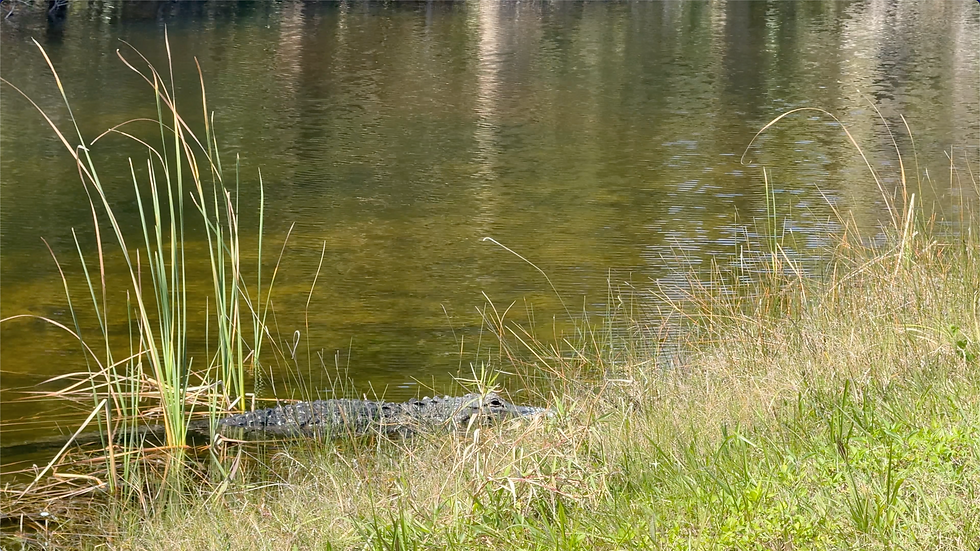Exploring Black Point Wildlife Drive: A Scenic 7-Mile Adventure on Florida’s Space Coast
- Chrissa Karnes

- Mar 16
- 4 min read

Black Point Wildlife Drive is one of Florida’s best-kept secrets, offering a 7-mile stretch of scenic beauty, diverse wildlife, and peaceful hiking trails. Nestled on Merritt Island along Florida’s Space Coast, this drive is a must-do for nature lovers, birdwatchers, and anyone looking to experience a slice of untouched Florida wilderness.
In this guide, I’ll take you through everything you need to know about Black Point Wildlife Drive, including what to expect at each stop, tips for wildlife viewing, and important visitor information.
Where is Black Point Wildlife Drive Located?
Black Point Wildlife Drive is located in Merritt Island, Florida, approximately 60 miles east of Orlando and just minutes from Kennedy Space Center.
At the entrance, you’ll find an information kiosk where you can pay the entry fee and grab a brochure that provides details about the 12 stops along the drive.
How Much Does It Cost to Visit Black Point Wildlife Drive?
Entry Fee: $10 per vehicle
Payment Options: Cash or online via a QR code at the information kiosk
Passes Accepted: National Parks passes
What to Expect on Black Point Wildlife Drive

Stop 1: National Wildlife Refuges – A Habitat for Wildlife

Black Point Wildlife Drive is part of the Merritt Island National Wildlife Refuge, which preserves vital habitats for a variety of wildlife. As you drive through, you’ll learn about habitat management techniques such as:
Water level control in impoundments
Prescribed burns to promote ecosystem health
Planting native species to support wildlife
Removing invasive plants and animals to protect the ecosystem
This stop sets the stage for why this refuge is such an important sanctuary for Florida’s wildlife.
Stop 2: Wildlife Viewing Tips & Etiquette

One of the highlights of Black Point Wildlife Drive is the abundance of wildlife, from alligators and otters to over 300 species of birds. To increase your chances of spotting wildlife, keep these tips in mind:
Drive slowly & stay quiet – Loud noises, slamming car doors, or playing music can startle animals.
Use your car as a blind – Many animals feel safer when you stay inside your vehicle.
Bring binoculars or a camera with a zoom lens for better viewing.
Best Time for Wildlife Viewing: Early morning or late afternoon when animals are most active.
Stop 3: Water Level Management for Mosquito Control
One unique aspect of Black Point Wildlife Drive is its mosquito control efforts. Flooding certain areas during peak breeding seasons (May-September) helps reduce mosquito populations, making it a more comfortable experience for visitors while maintaining a healthy ecosystem.
Stop 4: Wild Bird Hiking Trail – A Short Walk into Nature
If you want to stretch your legs, stop at the Wild Bird Hiking Trail, a ¼-mile round-trip trail featuring:
Wildlife observation blinds
A viewing scope for close-up birdwatching
This is a great place to take a short nature walk while spotting birds and small mammals in their natural habitat.
Stop 5: Life Along the Edge
At this stop, you'll learn about the importance of wetland habitats and the species that thrive at the water's edge, including wading birds, fish, and reptiles.
Stop 6: Life on the Mud Flats
At this stop, you'll discover how mudflats serve as a crucial habitat for shorebirds, fish, and invertebrates. These nutrient-rich areas provide essential feeding grounds for migrating birds and play a key role in the coastal ecosystem.
Stop 7: Shallow Water Management
Shallow water areas create ideal conditions for wading birds and fish, providing a rich feeding ground for multiple species.
Stop 8: On the Move, Mass Migration
During the winter months, this refuge is home to thousands of migratory birds that stop to rest and feed. Depending on the season, you may see a variety of ducks, pelicans, or even bald eagles.
Stop 9: Cruickshank Trail & Rest Area
For those looking for a longer hike, the Cruickshank Trail offers a 5-mile loop around the peninsula, providing:
A scenic observation tower overlooking the marsh
A wheelchair-accessible viewing platform
Opportunities to see flowers, birds, and maybe even an alligator!
Hiking Tip: This trail has no shade, so come early in the morning and bring plenty of water, sunscreen, and bug spray.
Stop 10: Restoration of the Marsh
The marsh on the left side of this stop was restored by removing the dike separating the marsh from the lagoon.
Between Stops 10 and 11 - Be on the lookout for alligators!

Alligators are commonly spotted between Stops 10 and 11, so keep your eyes peeled! They often bask in the sun near the water’s edge, blending in with their surroundings.
Stop 11: Eagles on the Refuge
Tall pine trees to your right proved an excellent location for eagles to nest.
Stop 12: The Edge Effect and Prescribed Fire Management
This stop highlights how controlled burns help maintain a healthy balance between forests and wetlands, preventing wildfires and encouraging new plant growth.
Tips for Visiting Black Point Wildlife Drive

Operating Hours: Open year-round from sunrise to sunset, except during NASA-restricted operations.
Entry Fee: $10 per vehicle (National Parks Passes accepted).
Pets: Allowed on trails but must be leashed.
Best Time to Visit: Early morning or late afternoon for the best wildlife sightings.
What to Bring:
Binoculars or a zoom camera
Sunscreen and bug spray
Plenty of water if hiking
A guidebook or app for bird identification
Final Thoughts
If you love scenic drives, birdwatching, and peaceful nature trails, Black Point Wildlife Drive is a must-visit. Whether you’re a Florida local or visiting the Space Coast, this hidden gem offers a relaxing and immersive wildlife experience.
Looking for more scenic drives in Florida? Check out Apopka Wildlife Drive, another incredible spot for seeing alligators and native Florida wildlife in their natural habitat!








































Comments